Scenario-Based Simulation of Tianjin City Using a Cellular Automata–Markov Model
Abstract
1. Introduction
2. Materials and Methods
2.1. Study Area
2.2. Data Used
2.3. Land Use/Cover Change Model
2.3.1. Computation of Transition Area Matrix Using the Markov Model
2.3.2. Generation of Transition Suitability Maps
2.3.3. Combination of the Markov and CA Models
2.4. Modeling Variables
2.5. Model Validation
2.6. Scenario Assumptions
3. Results and Model Assessment
3.1. Land Use/Cover Maps
3.2. Transition Matrix
3.3. Simulation in Three Scenarios
3.3.1. Environmental Protection Scenario
3.3.2. Cropland Protection Scenario
3.3.3. Spontaneous Scenario
3.4. Land Use/Cover Transition
4. Discussion
4.1. Prediction of Urbanization under Different Scenarios and Its Impact
4.2. Advantages of Scenario-Based Modeling
5. Conclusions
Author Contributions
Funding
Acknowledgments
Conflicts of Interest
References
- Li, Y.; He, C. Scenario simulation and forecast of land use/cover in northern China. Chin. Sci. Bull. 2008, 53, 1401. [Google Scholar] [CrossRef]
- Zhou, M. An interval fuzzy chance-constrained programming model for sustainable urban land-use planning and land use policy analysis. Land Use Policy 2015, 42, 479–491. [Google Scholar] [CrossRef]
- Zhang, R.; Matsushima, K.; Kobayashi, K. Can land use planning help mitigate transport-related carbon emissions? A case of Changzhou. Land Use Policy 2018, 74, 32–40. [Google Scholar] [CrossRef]
- Alqurashi, A.F.; Kumar, L.; Sinha, P. Urban land cover change modelling using time-series satellite images: A case study of urban growth in five cities of Saudi Arabia. Remote Sens. 2016, 8, 838. [Google Scholar] [CrossRef]
- Kindu, M.; Schneider, T.; Döllerer, M.; Teketay, D.; Knoke, T. Scenario modelling of land use/land cover changes in Munessa-Shashemene landscape of the Ethiopian highlands. Sci. Total Environ. 2018, 622–623, 534–546. [Google Scholar] [CrossRef] [PubMed]
- Geng, B.; Zheng, X.; Fu, M. Scenario analysis of sustainable intensive land use based on SD model. Sustain. Cities Soc. 2017, 29, 193–202. [Google Scholar] [CrossRef]
- Hu, Y.; Peng, J.; Liu, Y.; Tian, L. Integrating ecosystem services trade-offs with paddy land-to-dry land decisions: A scenario approach in Erhai Lake Basin, southwest China. Sci. Total Environ. 2018, 625, 849–860. [Google Scholar] [CrossRef] [PubMed]
- Wang, Y.-C.; Hu, B.K.H.; Myint, S.W.; Feng, C.-C.; Chow, W.T.L.; Passy, P.F. Patterns of land change and their potential impacts on land surface temperature change in Yangon, Myanmar. Sci. Total Environ. 2018, 643, 738–750. [Google Scholar] [CrossRef] [PubMed]
- Zhang, Q.; Ban, Y.; Liu, J.; Hu, Y. Simulation and analysis of urban growth scenarios for the Greater Shanghai Area, China. Comput. Environ. Urban Syst. 2011, 35, 126–139. [Google Scholar] [CrossRef]
- Tewolde, M.G.; Cabral, P. Urban sprawl analysis and modeling in Asmara, Eritrea. Remote Sens. 2011, 3, 2148–2165. [Google Scholar] [CrossRef]
- Clarke, K.C.; Hoppen, S.; Gaydos, L. A self-modifying cellular automaton model of historical urbanization in the San Francisco bay area. Environ. Plan. B Plan. Des. 1997, 24, 247–261. [Google Scholar] [CrossRef]
- Clarke, K.C.; Gaydos, L.J. Loose-coupling a cellular automaton model and GIS: Long-term urban growth prediction for San Francisco and Washington/Baltimore. Int. J. Geogr. Inf. Sci. 1998, 12, 699–714. [Google Scholar] [CrossRef] [PubMed]
- Seto, K.C.; Fragkias, M.; Güneralp, B.; Reilly, M.K. A meta-analysis of global urban land expansion. PLoS ONE 2011, 6, e23777. [Google Scholar] [CrossRef] [PubMed]
- Seto, K.C.; Fragkias, M. Quantifying spatiotemporal patterns of urban land-use change in four cities of China with time series landscape metrics. Landsc. Ecol. 2005, 20, 871–888. [Google Scholar] [CrossRef]
- Xue, F. A Review of Urbanization and Urban Development Since the Founding of New China. Available online: http://www.hprc.org.cn/gsyj/yjjg/zggsyjxh_1/gsnhlw_1/jjgslw/201110/t20111019_162379.html (accessed on 17 July 2018).
- National Bureau of Statistics of the People’s Republic of China. Available online: http://www.stats.gov.cn (accessed on 30 April 2018).
- Wang, M.; Zhang, X.; Yan, X. Modeling the climatic effects of urbanization in the Beijing–Tianjin–Hebei metropolitan area. Theor. Appl. Climatol. 2013, 113, 377–385. [Google Scholar] [CrossRef]
- Wang, R.; Murayama, Y. Change of land use/cover in Tianjin city based on the markov and cellular automata models. ISPRS Int. J. Geo-Inf. 2017, 6, 150. [Google Scholar] [CrossRef]
- National Forestry Census. Available online: http://www.forestry.gov.cn/gjslzyqc.html (accessed on 24 April 2018).
- Promote the Sustainable Development of Cities with Ecological Environment Construction (in CHINESE). Available online: http://www.tjszx.gov.cn/yzjy/system/2015/01/28/010001307.shtml (accessed on 25 April 2018).
- Tianjin Has Been One of the Most Water-Deficient Cities in the Northern China (in Chinese). Available online: http://env.people.com.cn/n/2014/0922/c1010-25706486-2.html (accessed on 28 April 2018).
- Dong, J.; Tang, T. The present situation of the species diversity in Tianjin and the reasons of its loss (in Chinese). In Proceedings of the Second National Symposium on the Conservation and Sustainable Use of Biological Diversity, Beijing, China, 20 November 1996. [Google Scholar]
- Tianjin Biodiversity Conservation Strategy Action Plan 2011–2030 (in Chinese). Available online: http://www.tjhb.gov.cn/root16/mechanism/the_natural_ecological_protection/201501/t20150120_13438.html (accessed on 27 April 2018).
- Reynolds, G.; Payne, J.; Sinun, W.; Mosigil, G.; Walsh, R.P.D. Changes in forest land use and management in Sabah, Malaysian Borneo, 1990–2010, with a focus on the Danum Valley region. Phil. Trans. R Soc. B 2011, 366, 3168–3176. [Google Scholar] [CrossRef] [PubMed]
- Liu, J.; Tian, H.; Liu, M.; Zhuang, D.; Melillo, J.M.; Zhang, Z. China’s changing landscape during the 1990s: Large-scale land transformations estimated with satellite data. Geophys. Res. Lett. 2005, 32, L02405. [Google Scholar] [CrossRef]
- Lichtenberg, E.; Ding, C. Assessing farmland protection policy in China. Land Use Policy 2008, 25, 59–68. [Google Scholar] [CrossRef]
- Skinner, M.W.; Kuhn, R.G.; Joseph, A.E. Agricultural land protection in China: A case study of local governance in Zhejiang Province. Land Use Policy 2001, 18, 329–340. [Google Scholar] [CrossRef]
- Tan, M.; Li, X.; Xie, H.; Lu, C. Urban land expansion and arable land loss in China—A case study of Beijing–Tianjin–Hebei region. Land Use Policy 2005, 22, 187–196. [Google Scholar] [CrossRef]
- Liang, C.; Penghui, J.; Wei, C.; Manchun, L.; Liyan, W.; Yuan, G.; Yuzhe, P.; Nan, X.; Yuewei, D.; Qiuhao, H. Farmland protection policies and rapid urbanization in China: A case study for Changzhou City. Land Use Policy 2015, 48, 552–566. [Google Scholar] [CrossRef]
- Kuang, W. Simulating dynamic urban expansion at regional scale in Beijing-Tianjin-Tangshan Metropolitan Area. J. Geogr. Sci. 2011, 21, 317. [Google Scholar] [CrossRef]
- Nunes de Oliveira, S.; Abílio de Carvalho Júnior, O.; Trancoso Gomes, R.A.; Fontes Guimarães, R.; McManus, C.M. Deforestation analysis in protected areas and scenario simulation for structural corridors in the agricultural frontier of Western Bahia, Brazil. Land Use Policy 2017, 61, 40–52. [Google Scholar] [CrossRef]
- Behera, M.D.; Borate, S.N.; Panda, S.N.; Behera, P.R.; Roy, P.S. Modelling and analyzing the watershed dynamics using Cellular Automata (CA)–Markov mode—A geo-information based approach. J. Earth Syst. Sci. 2012, 121, 1011–1024. [Google Scholar] [CrossRef]
- Mondal, P.; Southworth, J. Evaluation of conservation interventions using a cellular automata-Markov model. For. Ecol. Manag. 2010, 260, 1716–1725. [Google Scholar] [CrossRef]
- T Karst; Jan R Ritsema van Eck Evaluation of accessibility impacts of land-use scenarios: The implications of job competition, land-use, and infrastructure developments for the Netherlands. Environ. Plan. B Plan. Des. 2003, 30, 69–87. [CrossRef]
- Wang, R.; Derdouri, A.; Murayama, Y. Spatiotemporal simulation of future land use/cover change scenarios in the Tokyo metropolitan area. Sustainability 2018, 10, 2056. [Google Scholar] [CrossRef]
- Kamusoko, C.; Aniya, M.; Adi, B.; Manjoro, M. Rural sustainability under threat in Zimbabwe – Simulation of future land use/cover changes in the Bindura district based on the Markov-cellular automata model. Appl. Geogr. 2009, 29, 435–447. [Google Scholar] [CrossRef]
- Shi, H.; Chertow, M.; Song, Y. Developing country experience with eco-industrial parks: A case study of the Tianjin Economic-Technological Development Area in China. J. Clean. Prod. 2010, 18, 191–199. [Google Scholar] [CrossRef]
- Xue, M.; Luo, Y. Dynamic variations in ecosystem service value and sustainability of urban system: A case study for Tianjin city, China. Cities 2015, 46, 85–93. [Google Scholar] [CrossRef]
- Weng, Q. Remote sensing of impervious surfaces in the urban areas: Requirements, methods, and trends. Remote Sens. Environ. 2012, 117, 34–49. [Google Scholar] [CrossRef]
- U.S. Geological Survey. Available online: www.usgs.gov (accessed on 28 April 2018).
- Yen, P.; Ziegler, S.; Huettmann, F.; Onyeahialam, A.I. Change detection of forest and habitat resources from 1973 to 2001 in Bach Ma National Park, Vietnam, Using Remote Sensing Imagery. Available online: https://www.ingentaconnect.com/content/cfa/ifr/2005/00000007/00000001/art00001 (accessed on 12 July 2018).
- Nielsen, S.E.; Stenhouse, G.B.; Beyer, H.L.; Huettmann, F.; Boyce, M.S. Can natural disturbance-based forestry rescue a declining population of grizzly bears? Biol. Conserv. 2008, 141, 2193–2207. [Google Scholar] [CrossRef]
- Onyeahialam, A.; Huettmann, F.; Bertazzon, S. Modeling sage grouse: Progressive computational methods for linking a complex set of local, digital biodiversity and habitat data towards global conservation statements and decision-making systems. In Computational Science and Its Applications—ICCSA 2005; Lecture Notes in Computer Science; Springer: Berlin/Heidelberg, Germany, 2005; pp. 152–161. [Google Scholar]
- Wang, W.; Zhang, C.; Allen, J.M.; Li, W.; Boyer, M.A.; Segerson, K.; Silander, J.A. Analysis and prediction of land use changes related to invasive species and major driving forces in the state of connecticut. Land 2016, 5, 25. [Google Scholar] [CrossRef]
- Zhai, R.; Zhang, C.; Li, W.; Boyer, M.A.; Hanink, D. Prediction of land use change in long island sound watersheds using nighttime light data. Land 2016, 5, 44. [Google Scholar] [CrossRef]
- Gong, J.; Li, J.; Yang, J.; Li, S.; Tang, W. Land use and Land cover change in the qinghai lake region of the tibetan plateau and its impact on ecosystem services. Int. J. Environ. Res. Public. Health 2017, 14, 818. [Google Scholar] [CrossRef] [PubMed]
- Guan, D.; Li, H.; Inohae, T.; Su, W.; Nagaie, T.; Hokao, K. Modeling urban land use change by the integration of cellular automaton and Markov model. Ecol. Model. 2011, 222, 3761–3772. [Google Scholar] [CrossRef]
- Brown, D.G.; Pijanowski, B.C.; Duh, J.D. Modeling the relationships between land use and land cover on private lands in the Upper Midwest, USA. J. Environ. Manage. 2000, 59, 247–263. [Google Scholar] [CrossRef]
- Subedi, P.; Subedi, K.; Thapa, B. Application of a hybrid cellular automaton—Markov (CA-Markov) model in land-use change prediction: A case study of Saddle Creek Drainage Basin, Florida. Appl. Ecol. Environ. Sci. Appl. Ecol. Environ. Sci. 2013, 1, 126–132. [Google Scholar] [CrossRef]
- Irwin, E.G.; Geoghegan, J. Theory, data, methods: Developing spatially explicit economic models of land use change. Agric. Ecosyst. Environ. 2001, 85, 7–24. [Google Scholar] [CrossRef]
- Howard, D.M.; Howard, P.J.A.; Howard, D.C. A markov model projection of soil organic carbon stores following land use changes. J. Environ. Manag. 1995, 45, 287–302. [Google Scholar] [CrossRef]
- Batty, M.; Couclelis, H.; Eichen, M. Urban systems as cellular automata. Environ. Plan. B Plan. Des. 1997, 24, 159–164. [Google Scholar] [CrossRef]
- Kirik, E.; Vitova, T. Cellular automata pedestrian movement model SIgMA.CA: Model parameters as an instrument to regulate movement regimes. In Cellular Automata; Springer: Cham, Switzerland, 2014; pp. 501–507. [Google Scholar]
- Manneville, P.; Boccara, N.; Vichniac, G.Y.; Bidaux, R. Cellular Automata and Modeling of Complex Physical Systems. In Proceedings of the Winter School, Les Houches, France, 21–28 February 1989; Springer Science & Business Media: Berlin, Germany, 2012. ISBN 978-3-642-75259-9. [Google Scholar]
- Gaudreau, J.; Perez, L.; Drapeau, P. BorealFireSim: A GIS-based cellular automata model of wildfires for the boreal forest of Quebec in a climate change paradigm. Ecol. Inform. 2016, 32, 12–27. [Google Scholar] [CrossRef]
- Memarian, H.; Balasundram, S.K.; Talib, J.B.; Sung, C.T.B.; Sood, A.M.; Abbaspour, K. Validation of CA-Markov for simulation of land use and cover change in the Langat Basin, Malaysia. J. Geogr. Inf. Syst. 2012, 4, 542. [Google Scholar] [CrossRef]
- Samat, N.; Hasni, R.; Elhadary, Y.A.E. Modelling land use changes at the peri-urban areas using geographic information systems and cellular automata model. J. Sustain. Dev. 2011, 4, 72. [Google Scholar] [CrossRef]
- Long, H.; Liu, Y.; Hou, X.; Li, T.; Li, Y. Effects of land use transitions due to rapid urbanization on ecosystem services: Implications for urban planning in the new developing area of China. Habitat Int. 2014, 44, 536–544. [Google Scholar] [CrossRef]
- Jr, R.G.P.; Millones, M. Death to Kappa: Birth of quantity disagreement and allocation disagreement for accuracy assessment. Int. J. Remote Sens. 2011, 32, 4407–4429. [Google Scholar] [CrossRef]
- Ahmed, B.; Ahmed, R.; Zhu, X. Evaluation of model validation techniques in land cover dynamics. ISPRS Int. J. Geo-Inf. 2013, 2, 577–597. [Google Scholar] [CrossRef]
- The Outline of the National Overall Planning on Forest Land Conservation (in Chinese). Available online: http://www.forestry.gov.cn/uploadfile/main/2010-8/file/2010-8-25-782d45dbdeea41398ff31b1023814c13.pdf (accessed on 29 April 2018).
- Thapa, R.B.; Murayama, Y. Scenario based urban growth allocation in Kathmandu Valley, Nepal. Landsc. Urban Plan. 2012, 105, 140–148. [Google Scholar] [CrossRef]
- Liu, Y.; Fang, F.; Li, Y. Key issues of land use in China and implications for policy making. Land Use Policy 2014, 40, 6–12. [Google Scholar] [CrossRef]
- Singh, P.; Kikon, N.; Verma, P. Impact of land use change and urbanization on urban heat island in Lucknow city, Central India. A remote sensing based estimate. Sustain. Cities Soc. 2017, 32, 100–114. [Google Scholar] [CrossRef]
- The Regulation on the Implementation of the Land Administration Law of Peoples Republic of China (in Chinese). Available online: https://www.tuliu.com/read-32186.html (accessed on 29 April 2018).
- Dezhkam, S.; Amiri, B.J.; Darvishsefat, A.A.; Sakieh, Y. Simulating the urban growth dimensions and scenario prediction through sleuth model: A case study of Rasht County, Guilan, Iran. GeoJournal 2014, 79, 591–604. [Google Scholar] [CrossRef]
- Liu, J.; Liu, M.; Tian, H.; Zhuang, D.; Zhang, Z.; Zhang, W.; Tang, X.; Deng, X. Spatial and temporal patterns of China’s cropland during 1990–2000: An analysis based on Landsat TM data. Remote Sens. Environ. 2005, 98, 442–456. [Google Scholar] [CrossRef]
- Lambin, E.F.; Rounsevell, M.D.A.; Geist, H.J. Are agricultural land-use models able to predict changes in land-use intensity? Agric. Ecosyst. Environ. 2000, 82, 321–331. [Google Scholar] [CrossRef]
- He, J.; Liu, Y.; Yu, Y.; Tang, W.; Xiang, W.; Liu, D. A counterfactual scenario simulation approach for assessing the impact of farmland preservation policies on urban sprawl and food security in a major grain-producing area of China. Appl. Geogr. 2013, 37, 127–138. [Google Scholar] [CrossRef]
- Kusratmoko, E.; Albertus, S.D.Y.; Supriatna. Modelling land use/cover changes with Markov-cellular automata in Komering Watershed, South Sumatera. IOP Conf. Ser. Earth Environ. Sci. 2017, 54, 012103. [Google Scholar] [CrossRef]
- Cohen, B. Urban growth in developing countries: A review of current trends and a caution regarding existing forecasts. World Dev. 2004, 32, 23–51. [Google Scholar] [CrossRef]
- Daly, H.E.; Farley, J. Ecological Economics, Second Edition: Principles and Applications; Island Press: Washington, DC, USA, 2011; ISBN 978-1-59726-991-9. [Google Scholar]
- Yang, X.; Zheng, X.-Q.; Lv, L.-N. A spatiotemporal model of land use change based on ant colony optimization, Markov chain and cellular automata. Ecol. Model. 2012, 233, 11–19. [Google Scholar] [CrossRef]
- Pijanowski, B.C.; Tayyebi, A.; Doucette, J.; Pekin, B.K.; Braun, D.; Plourde, J. A big data urban growth simulation at a national scale: Configuring the GIS and neural network based land transformation model to run in a High Performance Computing (HPC) environment. Environ. Model. Softw. 2014, 51, 250–268. [Google Scholar] [CrossRef]
- Xu, Y.; Luo, D.; Guo, H.; Zhou, D. Multi-simulation of spatial distribution of land use based on CLUE-S model: A case study of Yuzhong County, Gansu Province. Beijing Daxue Xuebao Ziran Kexue BanActa Sci. Nat. Univ. Pekin. 2013, 49, 523–529. [Google Scholar]
- He, C.; Okada, N.; Zhang, Q.; Shi, P.; Zhang, J. Modeling urban expansion scenarios by coupling cellular automata model and system dynamic model in Beijing, China. Appl. Geogr. 2006, 26, 323–345. [Google Scholar] [CrossRef]
- Li, C.; Zhao, J.; Xu, Y. Examining spatiotemporally varying effects of urban expansion and the underlying driving factors. Sustain. Cities Soc. 2017, 28, 307–320. [Google Scholar] [CrossRef]
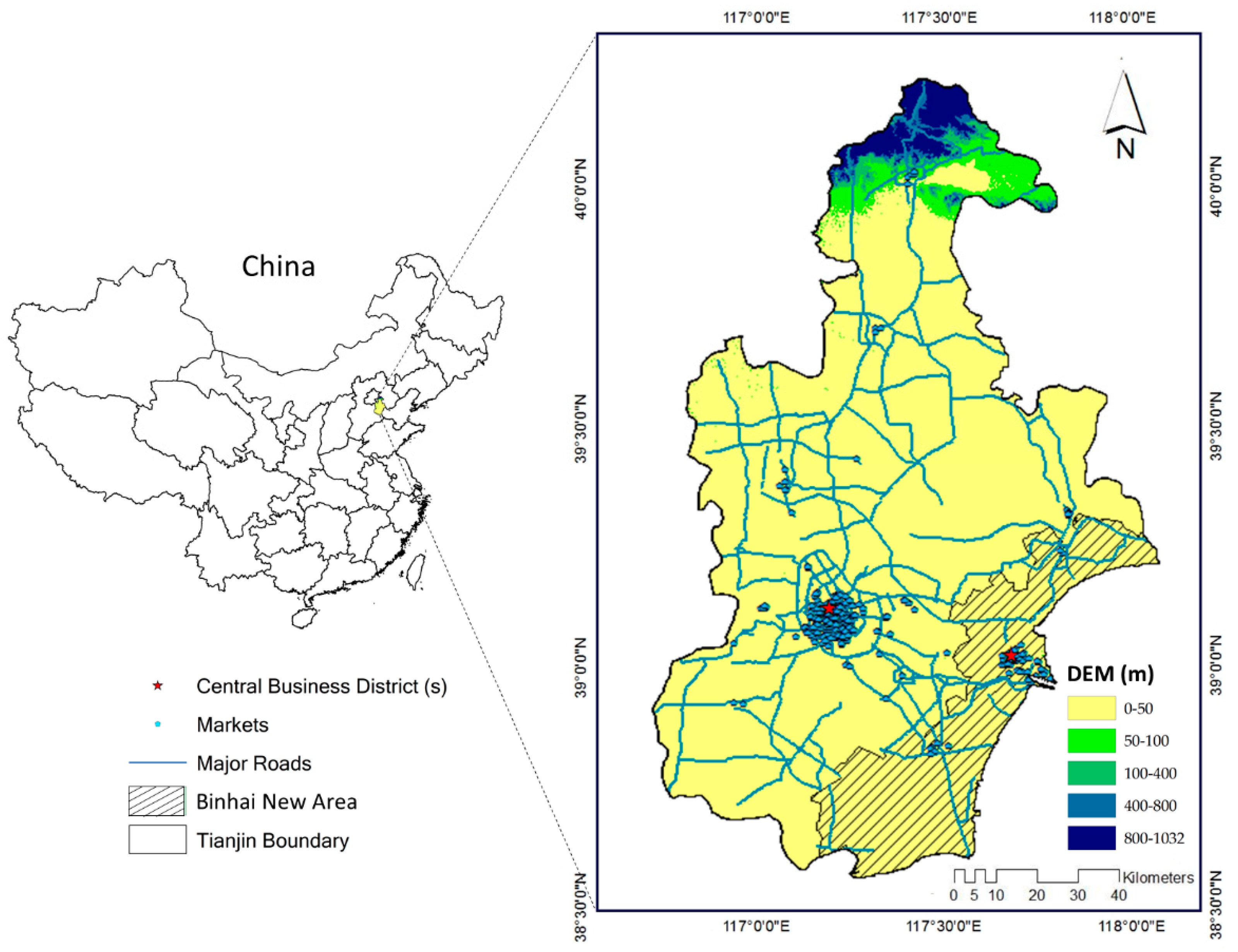
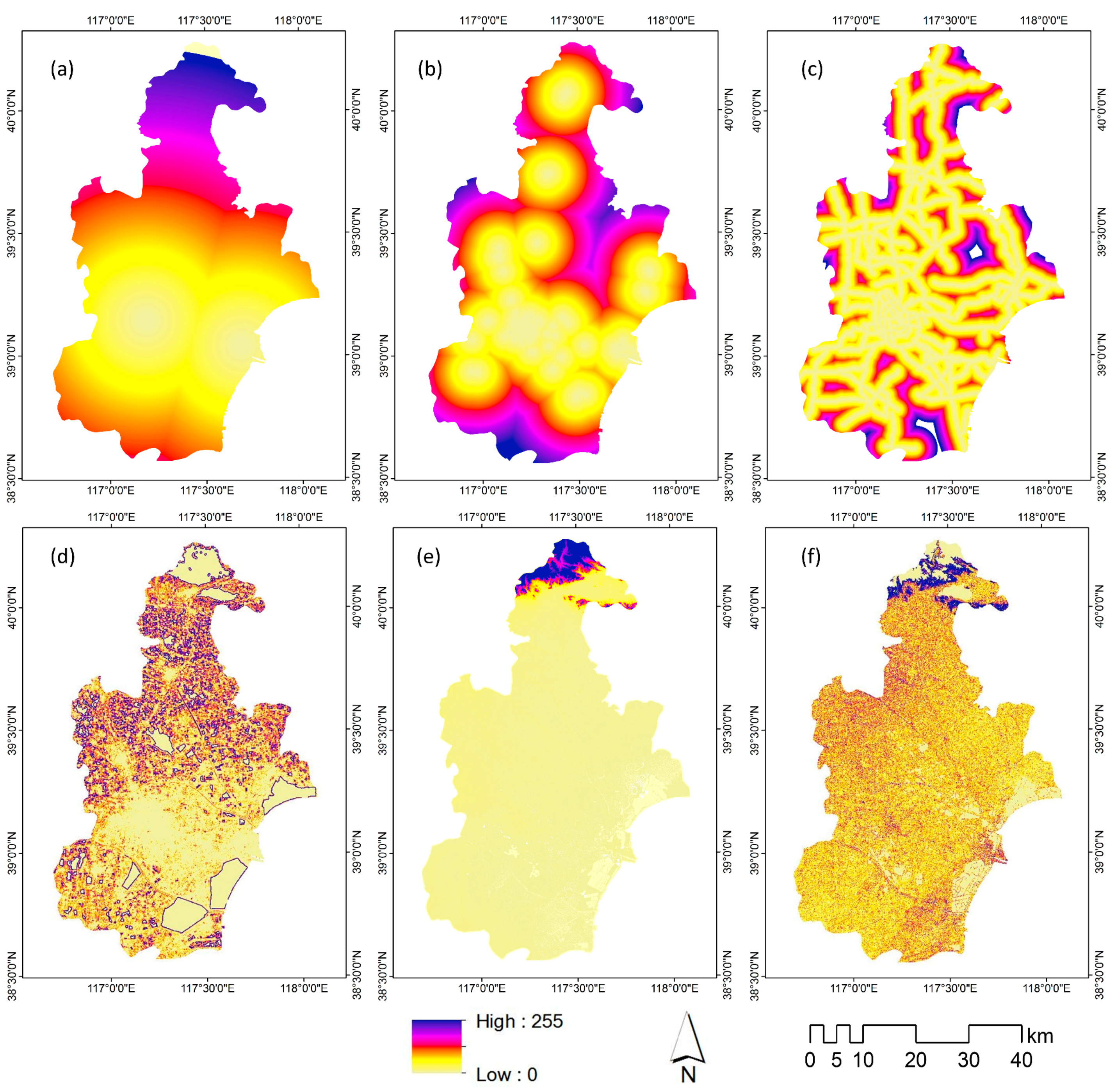



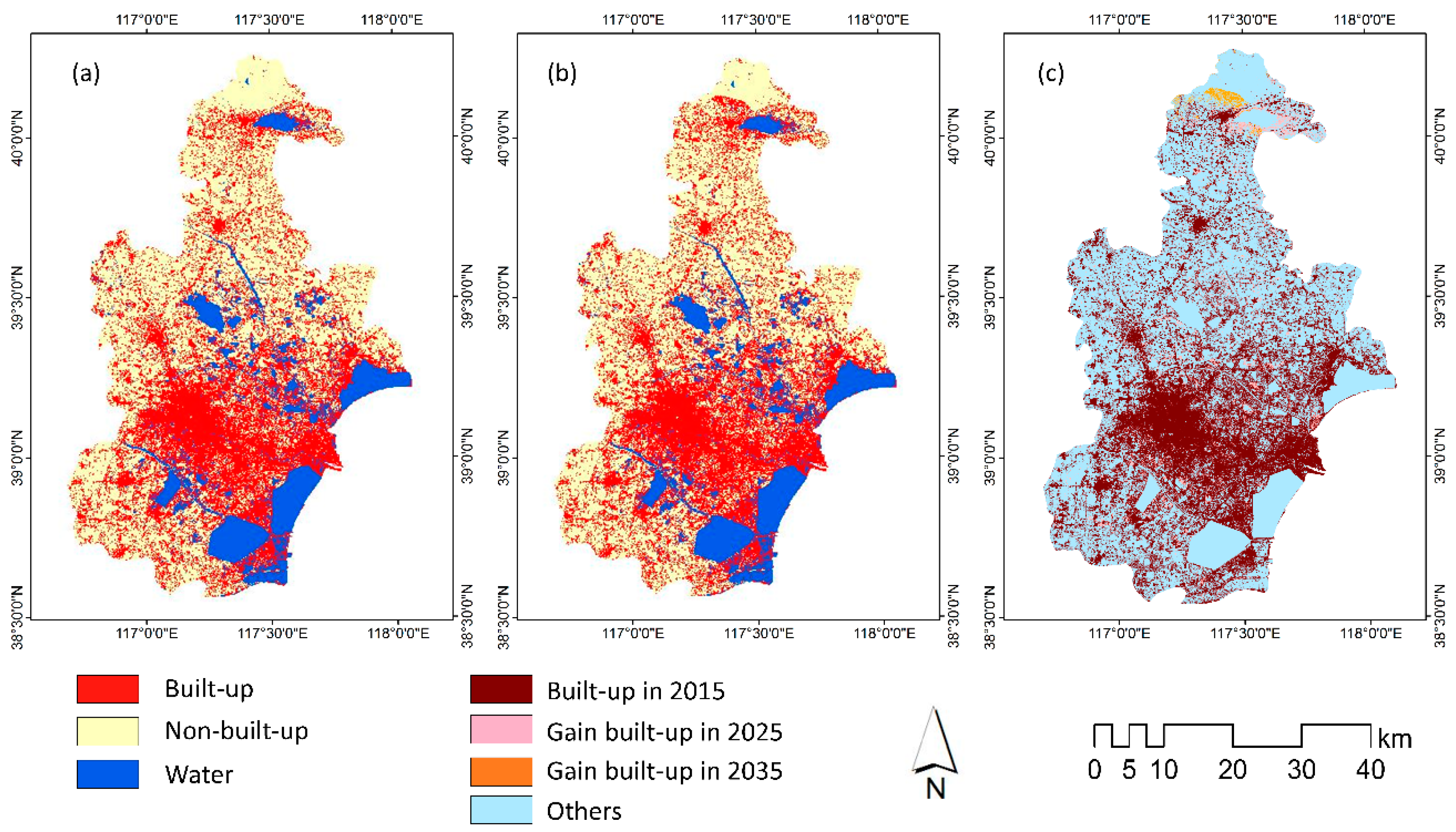
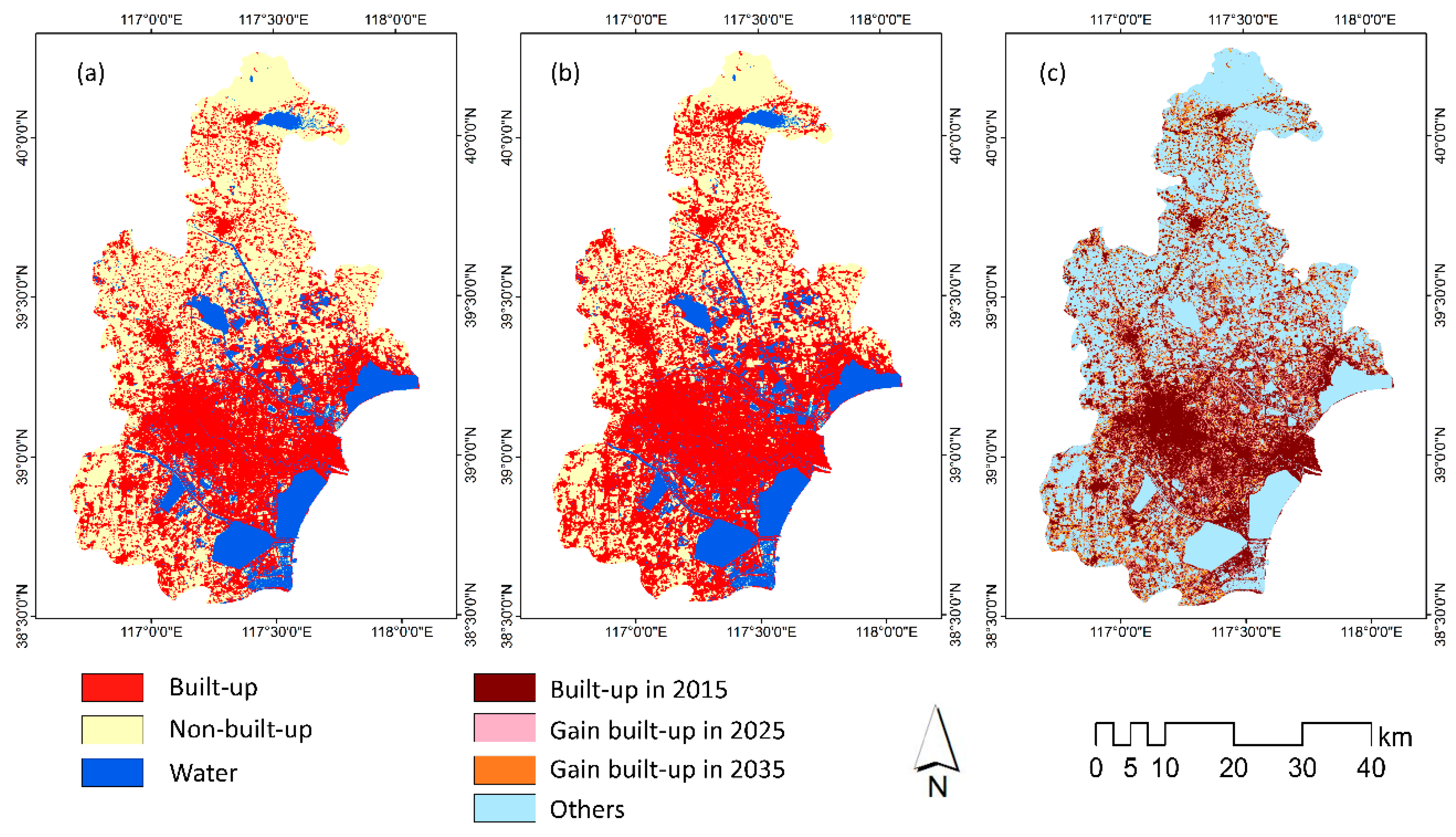

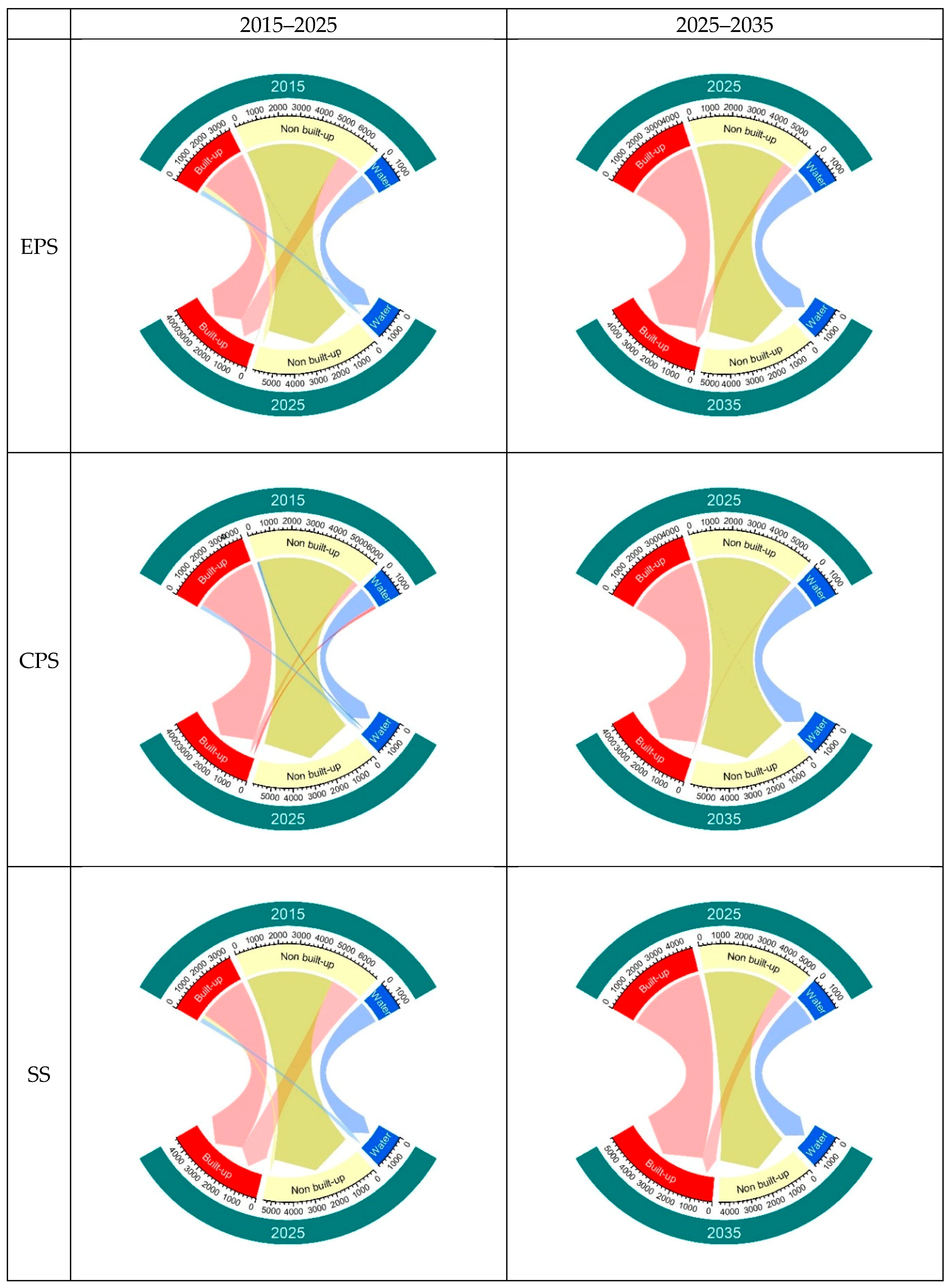
| Land Use/Cover Map 2015 | Land Use/Cover Map 2005 | ||
|---|---|---|---|
| Built-Up | Non-Built-Up | Water | |
| Built-up | 0.83 | 0.17 | 0 |
| Non-built-up | 0.3243 | 0.6527 | 0.023 |
| Water | 0 | 0.1458 | 0.8542 |
| 2015–2025 | 2025 | 2025–2035 | 2035 | |||
|---|---|---|---|---|---|---|
| Area Change | Land Use/Cover | Area Change | Land Use/Cover | |||
| Unit | (Sq km) | (Sq km) | (%) | (Sq km) | (Sq km) | (%) |
| Built-up | 924.52 | 4328.81 | 37.05 | 190.53 | 4519.34 | 38.68 |
| Non-built-up | −921.01 | 5975.12 | 51.14 | −162.34 | 5812.79 | 49.75 |
| Water | −3.52 | 1380.80 | 11.82 | −28.19 | 1352.61 | 11.58 |
| 2015–2025 | 2025 | 2025–2035 | 2035 | |||
|---|---|---|---|---|---|---|
| Area Change | Land Use/Cover | Area Change | Land Use/Cover | |||
| Unit | (Sq km) | (Sq km) | (%) | (Sq km) | (Sq km) | (%) |
| Built-up | 214.35 | 4227.07 | 34.35 | 58.54 | 4285.61 | 36.18 |
| Non-built-up | −411.00 | 5847.03 | 53.56 | −61.99 | 5785.04 | 50.05 |
| Water | 195.43 | 1609.42 | 12.10 | 3.43 | 1612.85 | 1378 |
| 2015–2025 | 2025 | 2025–2035 | 2035 | |||
|---|---|---|---|---|---|---|
| Area Change | Land Use/Cover | Area Change | Land Use/Cover | |||
| Unit | (Sq km) | (Sq km) | (%) | (Sq km) | (Sq km) | (%) |
| Built-up | 1278.31 | 4682.60 | 40.07 | 918.81 | 5601.41 | 47.94 |
| Non-built-up | −1500.02 | 5396.11 | 46.18 | −917.84 | 4478.27 | 38.33 |
| Water | 221.71 | 1606.03 | 13.74 | −0.97 | 1605.06 | 13.74 |
© 2018 by the authors. Licensee MDPI, Basel, Switzerland. This article is an open access article distributed under the terms and conditions of the Creative Commons Attribution (CC BY) license (http://creativecommons.org/licenses/by/4.0/).
Share and Cite
Wang, R.; Hou, H.; Murayama, Y. Scenario-Based Simulation of Tianjin City Using a Cellular Automata–Markov Model. Sustainability 2018, 10, 2633. https://doi.org/10.3390/su10082633
Wang R, Hou H, Murayama Y. Scenario-Based Simulation of Tianjin City Using a Cellular Automata–Markov Model. Sustainability. 2018; 10(8):2633. https://doi.org/10.3390/su10082633
Chicago/Turabian StyleWang, Ruci, Hao Hou, and Yuji Murayama. 2018. "Scenario-Based Simulation of Tianjin City Using a Cellular Automata–Markov Model" Sustainability 10, no. 8: 2633. https://doi.org/10.3390/su10082633
APA StyleWang, R., Hou, H., & Murayama, Y. (2018). Scenario-Based Simulation of Tianjin City Using a Cellular Automata–Markov Model. Sustainability, 10(8), 2633. https://doi.org/10.3390/su10082633







